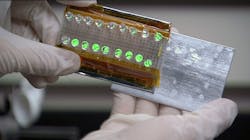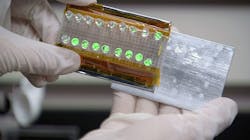Triboelectric generators use friction to create electricity
Researchers at Georgia Institute of Technology are trying to harness the electricity-generating phenomenon (also called the triboelectric effect) displayed when someone walks across a carpet, touches a doorknob, and gets a small shock. They envision it being used to power mobile devices and sensors by capturing otherwise wasted mechanical energy from sources such as walking, the wind blowing, ocean waves, and even cars driving by.
The GIT team has already built a prototype generator that uses sheets of dissimilar materials, one an electron donor, the other an electron acceptor. When the materials touch each other, electrons flow freely between them. But separate the sheets and they will each hold an electric charge isolated by the gap between them. Connect an electrical load to the two sheets and a small current flows to equalize the charges on each sheet. Repeating this process generates an ac current.
Georgia Tech engineers have boosted the power output density of their triboelectric generator by a factor of 100,000 over the past 18 months. They claim to get as much as 300 W from a single layer of inexpensive polymer measuring a square meter. This means the volume power density reaches more than 400 kW/m3 and efficiencies above 50%.
One technique they discovered for improving the generating capabilities of polymer sheets is to etch micron-scale patterns into them. This increases the contact area and the effectiveness of charge transfer. They also found they could use fabrics and papers, and even generate electricity from contact between a patterned polymer sheet and water – seawater, tap water, or distilled water.
One of the first applications, according to researchers, will likely be sensors with no conventional power source. When the sensors are disturbed, they would generate electricity that could be used to measure sudden movements, changes in flow rates, or falling raindrops.
The team will continue to work at improving the devices’ output and sensitivity and determining if the effect can be scaled up by using larger sheets of polymers or adding more layers.

